MGT704 Report: Woolworths' International Expansion into South Africa
VerifiedAdded on 2022/10/07
|16
|3645
|19
Report
AI Summary
This report provides a comprehensive analysis of Woolworths' international business expansion, with a specific focus on its entry into the South African market. It begins with an executive summary and table of contents, followed by an introduction that discusses the increasing trend of globalization and international trade. The report then delves into a detailed examination of Woolworths Group Limited, including its operations and market presence. Internal and external market analyses are conducted, utilizing Porter's Five Forces to assess organizational competency. An international market analysis, focusing on South Africa, is presented, along with a comparative analysis using Hofstede's cultural dimensions to understand the cultural differences between Australia and China. The report further examines Woolworths' internationalization strategy of indirect exporting through domestic-based export intermediaries, specifically its online store on Tmall Global. The CAGE framework is applied to analyze cultural, administrative, geographic, and economic distances. The report concludes with recommendations and a summary of the findings, providing a thorough understanding of Woolworths' approach to global expansion and its strategic considerations in entering foreign markets.
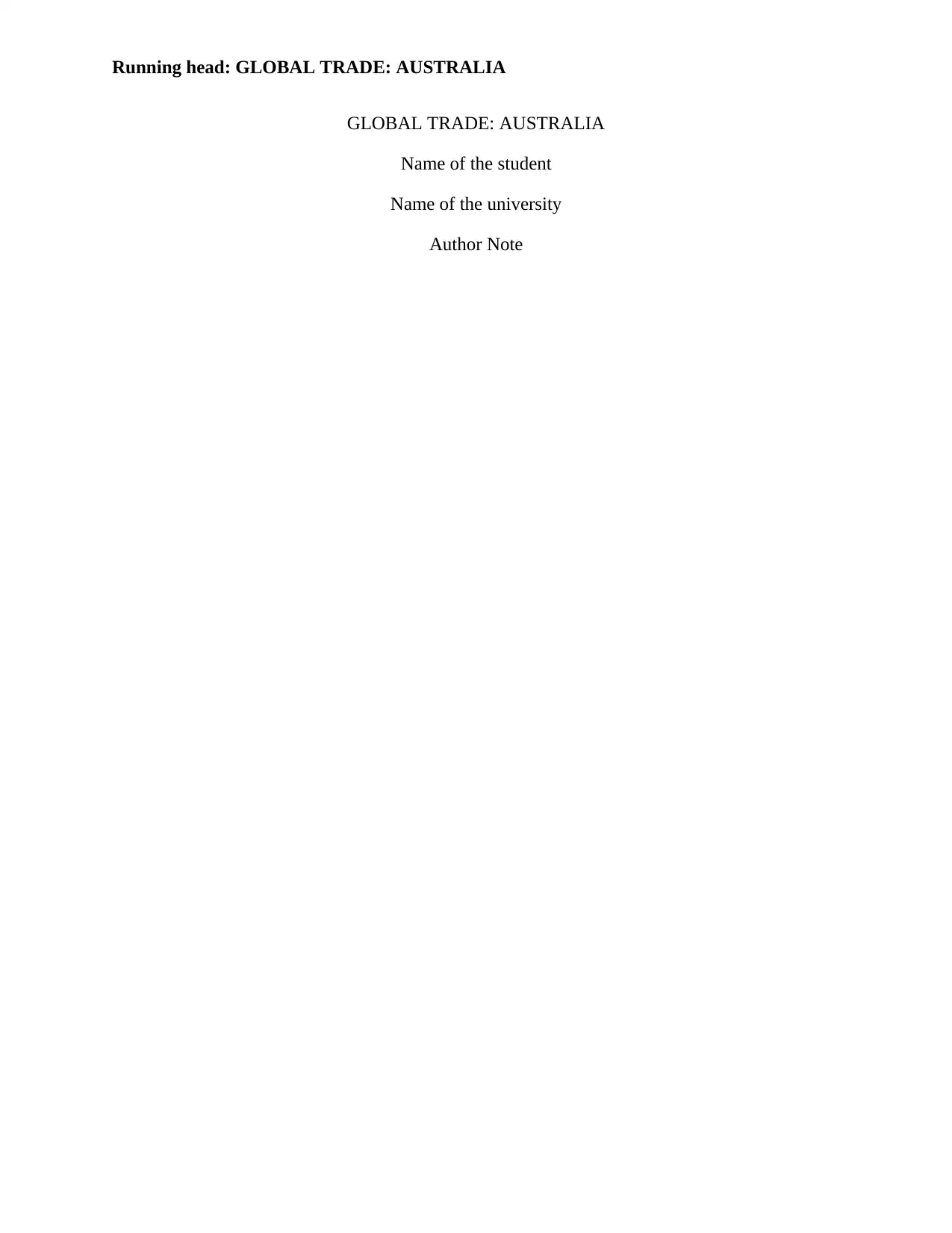
Running head: GLOBAL TRADE: AUSTRALIA
GLOBAL TRADE: AUSTRALIA
Name of the student
Name of the university
Author Note
GLOBAL TRADE: AUSTRALIA
Name of the student
Name of the university
Author Note
Paraphrase This Document
Need a fresh take? Get an instant paraphrase of this document with our AI Paraphraser
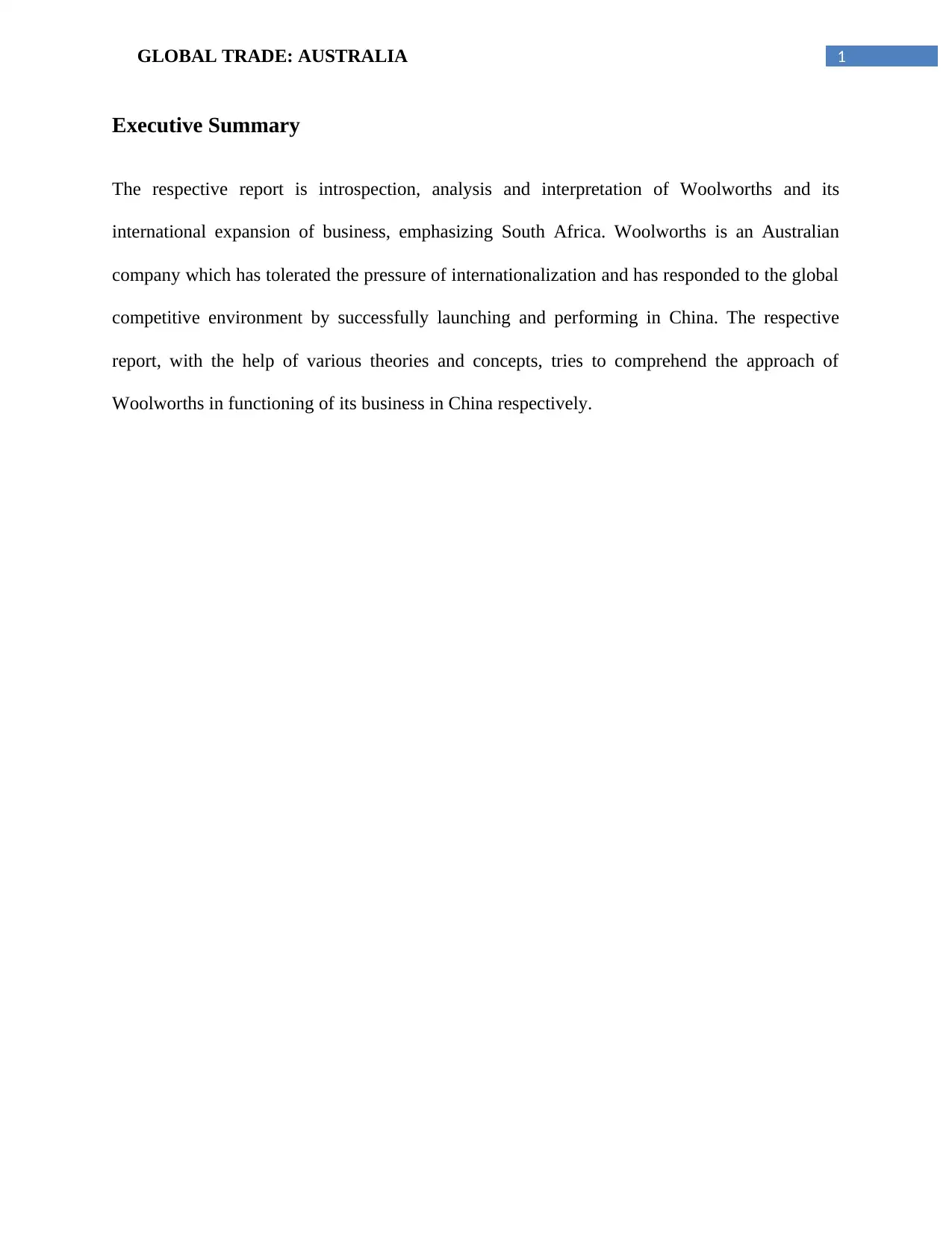
1GLOBAL TRADE: AUSTRALIA
Executive Summary
The respective report is introspection, analysis and interpretation of Woolworths and its
international expansion of business, emphasizing South Africa. Woolworths is an Australian
company which has tolerated the pressure of internationalization and has responded to the global
competitive environment by successfully launching and performing in China. The respective
report, with the help of various theories and concepts, tries to comprehend the approach of
Woolworths in functioning of its business in China respectively.
Executive Summary
The respective report is introspection, analysis and interpretation of Woolworths and its
international expansion of business, emphasizing South Africa. Woolworths is an Australian
company which has tolerated the pressure of internationalization and has responded to the global
competitive environment by successfully launching and performing in China. The respective
report, with the help of various theories and concepts, tries to comprehend the approach of
Woolworths in functioning of its business in China respectively.
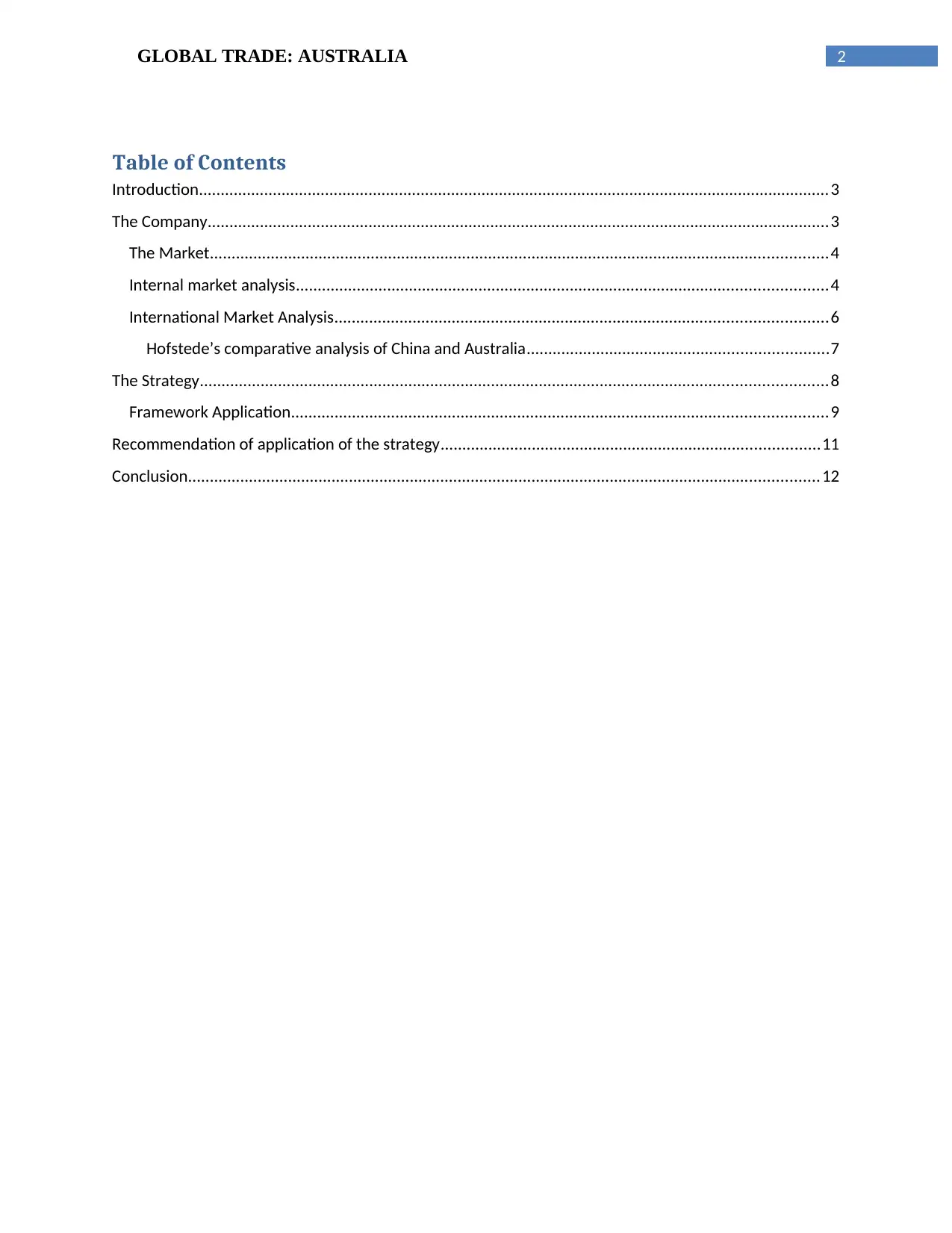
2GLOBAL TRADE: AUSTRALIA
Table of Contents
Introduction.................................................................................................................................................3
The Company...............................................................................................................................................3
The Market..............................................................................................................................................4
Internal market analysis..........................................................................................................................4
International Market Analysis.................................................................................................................6
Hofstede’s comparative analysis of China and Australia.....................................................................7
The Strategy................................................................................................................................................8
Framework Application...........................................................................................................................9
Recommendation of application of the strategy.......................................................................................11
Conclusion.................................................................................................................................................12
Table of Contents
Introduction.................................................................................................................................................3
The Company...............................................................................................................................................3
The Market..............................................................................................................................................4
Internal market analysis..........................................................................................................................4
International Market Analysis.................................................................................................................6
Hofstede’s comparative analysis of China and Australia.....................................................................7
The Strategy................................................................................................................................................8
Framework Application...........................................................................................................................9
Recommendation of application of the strategy.......................................................................................11
Conclusion.................................................................................................................................................12
⊘ This is a preview!⊘
Do you want full access?
Subscribe today to unlock all pages.

Trusted by 1+ million students worldwide
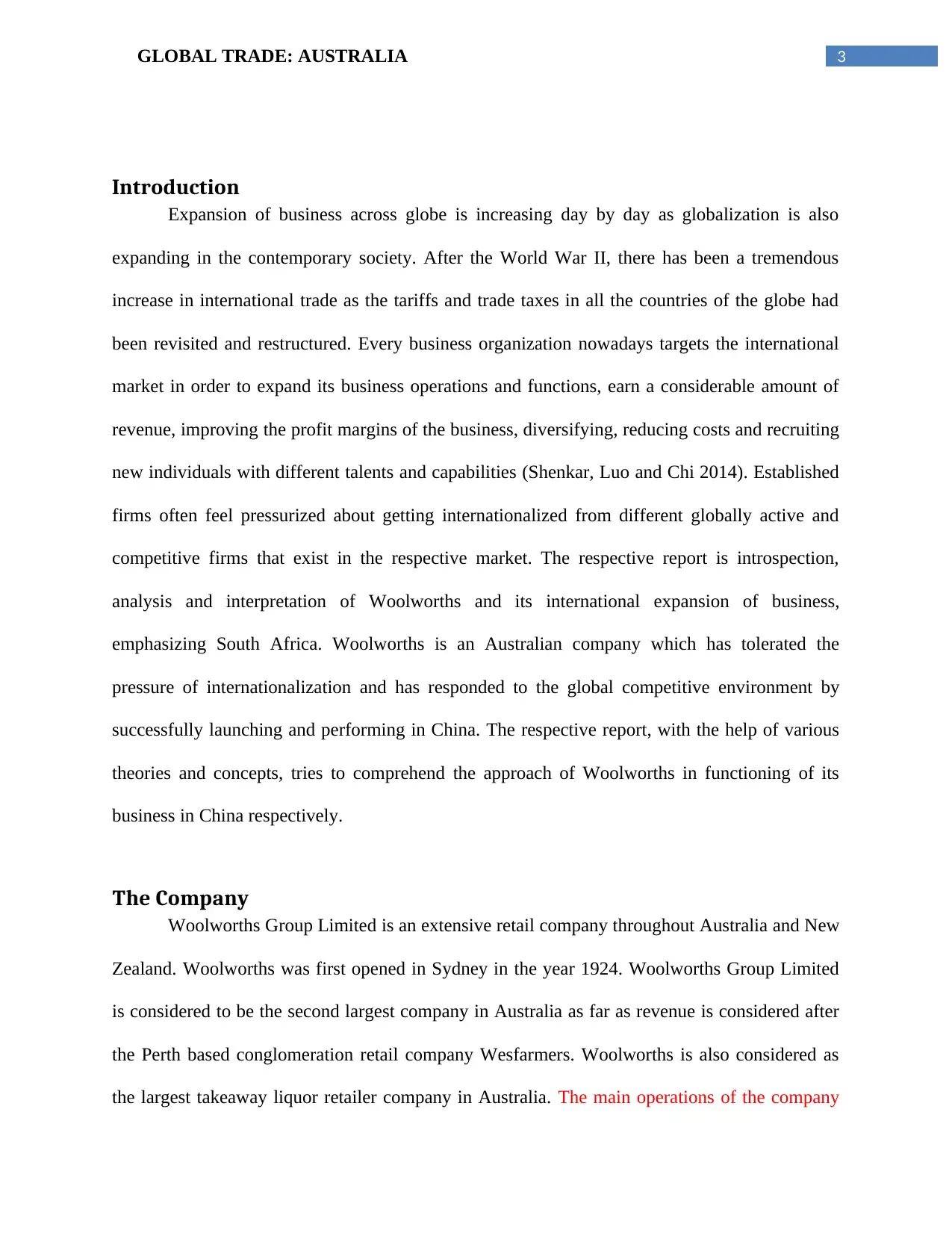
3GLOBAL TRADE: AUSTRALIA
Introduction
Expansion of business across globe is increasing day by day as globalization is also
expanding in the contemporary society. After the World War II, there has been a tremendous
increase in international trade as the tariffs and trade taxes in all the countries of the globe had
been revisited and restructured. Every business organization nowadays targets the international
market in order to expand its business operations and functions, earn a considerable amount of
revenue, improving the profit margins of the business, diversifying, reducing costs and recruiting
new individuals with different talents and capabilities (Shenkar, Luo and Chi 2014). Established
firms often feel pressurized about getting internationalized from different globally active and
competitive firms that exist in the respective market. The respective report is introspection,
analysis and interpretation of Woolworths and its international expansion of business,
emphasizing South Africa. Woolworths is an Australian company which has tolerated the
pressure of internationalization and has responded to the global competitive environment by
successfully launching and performing in China. The respective report, with the help of various
theories and concepts, tries to comprehend the approach of Woolworths in functioning of its
business in China respectively.
The Company
Woolworths Group Limited is an extensive retail company throughout Australia and New
Zealand. Woolworths was first opened in Sydney in the year 1924. Woolworths Group Limited
is considered to be the second largest company in Australia as far as revenue is considered after
the Perth based conglomeration retail company Wesfarmers. Woolworths is also considered as
the largest takeaway liquor retailer company in Australia. The main operations of the company
Introduction
Expansion of business across globe is increasing day by day as globalization is also
expanding in the contemporary society. After the World War II, there has been a tremendous
increase in international trade as the tariffs and trade taxes in all the countries of the globe had
been revisited and restructured. Every business organization nowadays targets the international
market in order to expand its business operations and functions, earn a considerable amount of
revenue, improving the profit margins of the business, diversifying, reducing costs and recruiting
new individuals with different talents and capabilities (Shenkar, Luo and Chi 2014). Established
firms often feel pressurized about getting internationalized from different globally active and
competitive firms that exist in the respective market. The respective report is introspection,
analysis and interpretation of Woolworths and its international expansion of business,
emphasizing South Africa. Woolworths is an Australian company which has tolerated the
pressure of internationalization and has responded to the global competitive environment by
successfully launching and performing in China. The respective report, with the help of various
theories and concepts, tries to comprehend the approach of Woolworths in functioning of its
business in China respectively.
The Company
Woolworths Group Limited is an extensive retail company throughout Australia and New
Zealand. Woolworths was first opened in Sydney in the year 1924. Woolworths Group Limited
is considered to be the second largest company in Australia as far as revenue is considered after
the Perth based conglomeration retail company Wesfarmers. Woolworths is also considered as
the largest takeaway liquor retailer company in Australia. The main operations of the company
Paraphrase This Document
Need a fresh take? Get an instant paraphrase of this document with our AI Paraphraser
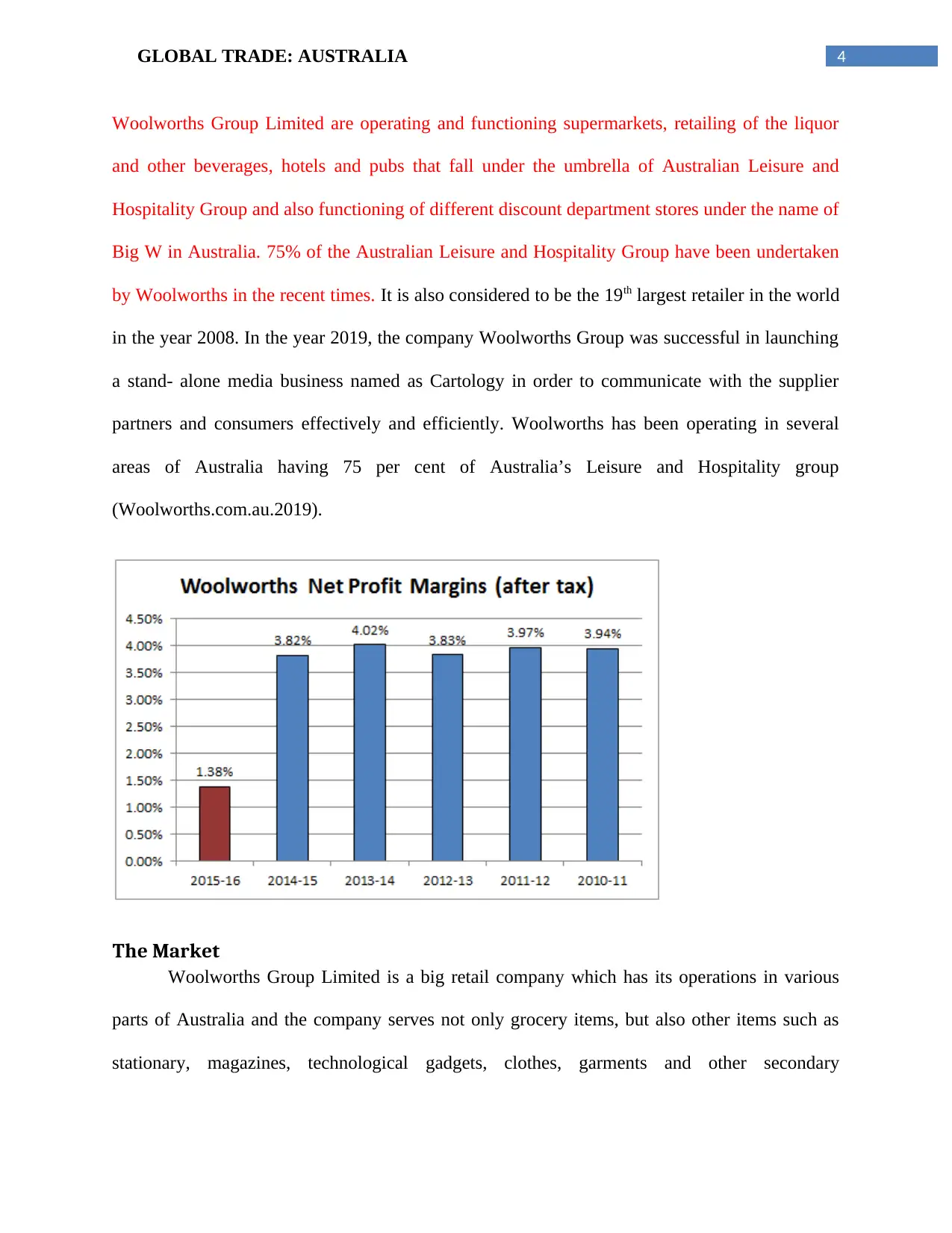
4GLOBAL TRADE: AUSTRALIA
Woolworths Group Limited are operating and functioning supermarkets, retailing of the liquor
and other beverages, hotels and pubs that fall under the umbrella of Australian Leisure and
Hospitality Group and also functioning of different discount department stores under the name of
Big W in Australia. 75% of the Australian Leisure and Hospitality Group have been undertaken
by Woolworths in the recent times. It is also considered to be the 19th largest retailer in the world
in the year 2008. In the year 2019, the company Woolworths Group was successful in launching
a stand- alone media business named as Cartology in order to communicate with the supplier
partners and consumers effectively and efficiently. Woolworths has been operating in several
areas of Australia having 75 per cent of Australia’s Leisure and Hospitality group
(Woolworths.com.au.2019).
The Market
Woolworths Group Limited is a big retail company which has its operations in various
parts of Australia and the company serves not only grocery items, but also other items such as
stationary, magazines, technological gadgets, clothes, garments and other secondary
Woolworths Group Limited are operating and functioning supermarkets, retailing of the liquor
and other beverages, hotels and pubs that fall under the umbrella of Australian Leisure and
Hospitality Group and also functioning of different discount department stores under the name of
Big W in Australia. 75% of the Australian Leisure and Hospitality Group have been undertaken
by Woolworths in the recent times. It is also considered to be the 19th largest retailer in the world
in the year 2008. In the year 2019, the company Woolworths Group was successful in launching
a stand- alone media business named as Cartology in order to communicate with the supplier
partners and consumers effectively and efficiently. Woolworths has been operating in several
areas of Australia having 75 per cent of Australia’s Leisure and Hospitality group
(Woolworths.com.au.2019).
The Market
Woolworths Group Limited is a big retail company which has its operations in various
parts of Australia and the company serves not only grocery items, but also other items such as
stationary, magazines, technological gadgets, clothes, garments and other secondary
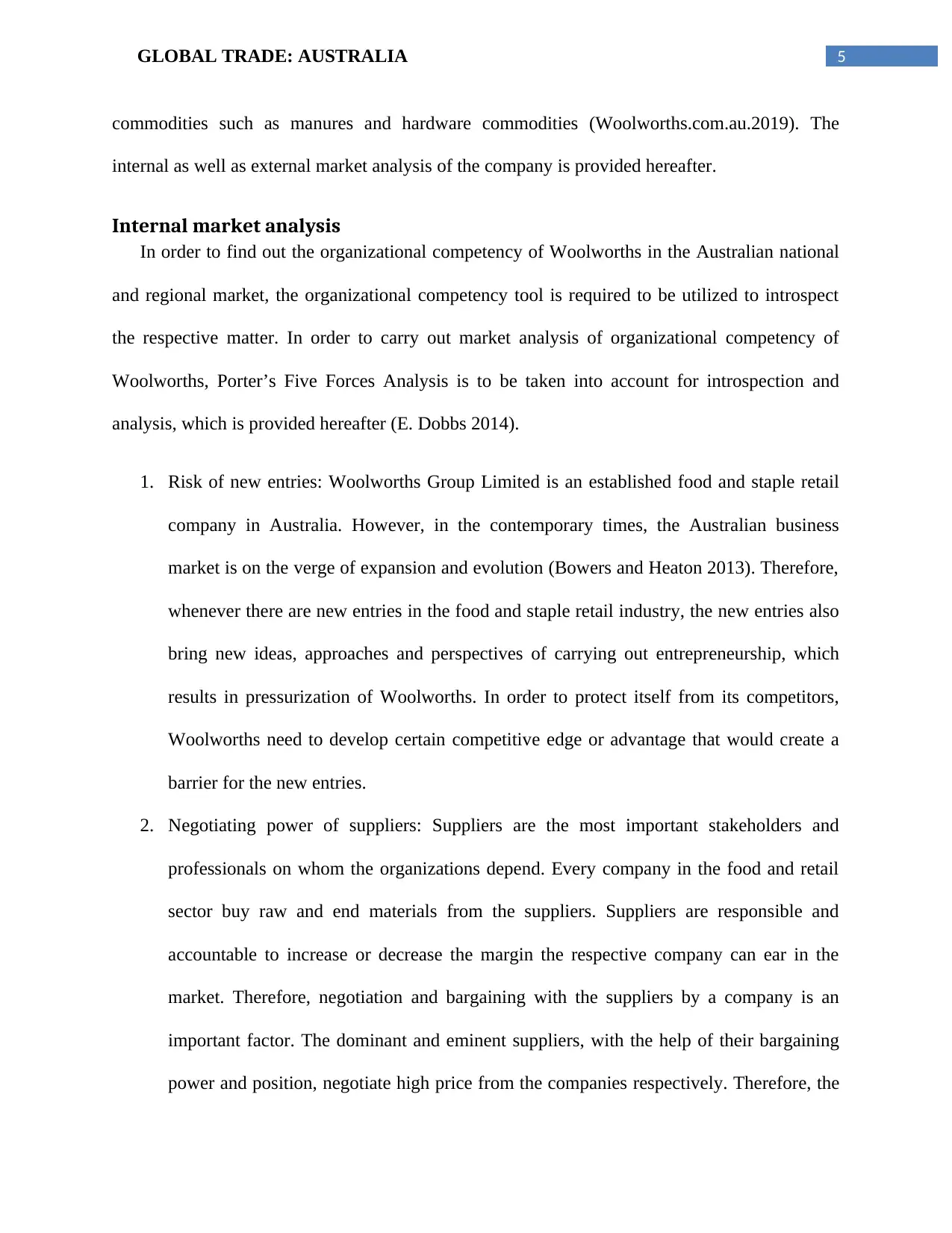
5GLOBAL TRADE: AUSTRALIA
commodities such as manures and hardware commodities (Woolworths.com.au.2019). The
internal as well as external market analysis of the company is provided hereafter.
Internal market analysis
In order to find out the organizational competency of Woolworths in the Australian national
and regional market, the organizational competency tool is required to be utilized to introspect
the respective matter. In order to carry out market analysis of organizational competency of
Woolworths, Porter’s Five Forces Analysis is to be taken into account for introspection and
analysis, which is provided hereafter (E. Dobbs 2014).
1. Risk of new entries: Woolworths Group Limited is an established food and staple retail
company in Australia. However, in the contemporary times, the Australian business
market is on the verge of expansion and evolution (Bowers and Heaton 2013). Therefore,
whenever there are new entries in the food and staple retail industry, the new entries also
bring new ideas, approaches and perspectives of carrying out entrepreneurship, which
results in pressurization of Woolworths. In order to protect itself from its competitors,
Woolworths need to develop certain competitive edge or advantage that would create a
barrier for the new entries.
2. Negotiating power of suppliers: Suppliers are the most important stakeholders and
professionals on whom the organizations depend. Every company in the food and retail
sector buy raw and end materials from the suppliers. Suppliers are responsible and
accountable to increase or decrease the margin the respective company can ear in the
market. Therefore, negotiation and bargaining with the suppliers by a company is an
important factor. The dominant and eminent suppliers, with the help of their bargaining
power and position, negotiate high price from the companies respectively. Therefore, the
commodities such as manures and hardware commodities (Woolworths.com.au.2019). The
internal as well as external market analysis of the company is provided hereafter.
Internal market analysis
In order to find out the organizational competency of Woolworths in the Australian national
and regional market, the organizational competency tool is required to be utilized to introspect
the respective matter. In order to carry out market analysis of organizational competency of
Woolworths, Porter’s Five Forces Analysis is to be taken into account for introspection and
analysis, which is provided hereafter (E. Dobbs 2014).
1. Risk of new entries: Woolworths Group Limited is an established food and staple retail
company in Australia. However, in the contemporary times, the Australian business
market is on the verge of expansion and evolution (Bowers and Heaton 2013). Therefore,
whenever there are new entries in the food and staple retail industry, the new entries also
bring new ideas, approaches and perspectives of carrying out entrepreneurship, which
results in pressurization of Woolworths. In order to protect itself from its competitors,
Woolworths need to develop certain competitive edge or advantage that would create a
barrier for the new entries.
2. Negotiating power of suppliers: Suppliers are the most important stakeholders and
professionals on whom the organizations depend. Every company in the food and retail
sector buy raw and end materials from the suppliers. Suppliers are responsible and
accountable to increase or decrease the margin the respective company can ear in the
market. Therefore, negotiation and bargaining with the suppliers by a company is an
important factor. The dominant and eminent suppliers, with the help of their bargaining
power and position, negotiate high price from the companies respectively. Therefore, the
⊘ This is a preview!⊘
Do you want full access?
Subscribe today to unlock all pages.

Trusted by 1+ million students worldwide
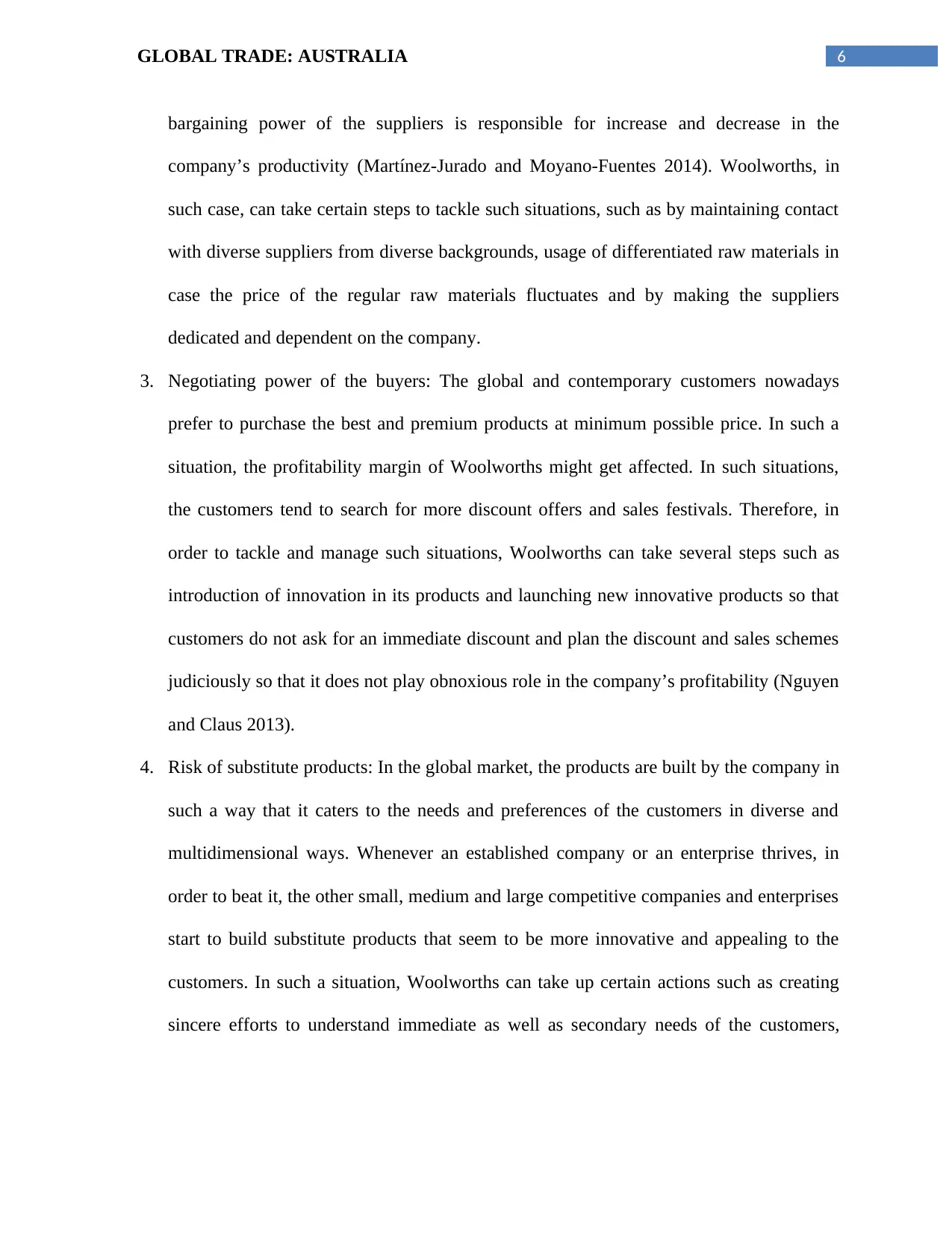
6GLOBAL TRADE: AUSTRALIA
bargaining power of the suppliers is responsible for increase and decrease in the
company’s productivity (Martínez-Jurado and Moyano-Fuentes 2014). Woolworths, in
such case, can take certain steps to tackle such situations, such as by maintaining contact
with diverse suppliers from diverse backgrounds, usage of differentiated raw materials in
case the price of the regular raw materials fluctuates and by making the suppliers
dedicated and dependent on the company.
3. Negotiating power of the buyers: The global and contemporary customers nowadays
prefer to purchase the best and premium products at minimum possible price. In such a
situation, the profitability margin of Woolworths might get affected. In such situations,
the customers tend to search for more discount offers and sales festivals. Therefore, in
order to tackle and manage such situations, Woolworths can take several steps such as
introduction of innovation in its products and launching new innovative products so that
customers do not ask for an immediate discount and plan the discount and sales schemes
judiciously so that it does not play obnoxious role in the company’s profitability (Nguyen
and Claus 2013).
4. Risk of substitute products: In the global market, the products are built by the company in
such a way that it caters to the needs and preferences of the customers in diverse and
multidimensional ways. Whenever an established company or an enterprise thrives, in
order to beat it, the other small, medium and large competitive companies and enterprises
start to build substitute products that seem to be more innovative and appealing to the
customers. In such a situation, Woolworths can take up certain actions such as creating
sincere efforts to understand immediate as well as secondary needs of the customers,
bargaining power of the suppliers is responsible for increase and decrease in the
company’s productivity (Martínez-Jurado and Moyano-Fuentes 2014). Woolworths, in
such case, can take certain steps to tackle such situations, such as by maintaining contact
with diverse suppliers from diverse backgrounds, usage of differentiated raw materials in
case the price of the regular raw materials fluctuates and by making the suppliers
dedicated and dependent on the company.
3. Negotiating power of the buyers: The global and contemporary customers nowadays
prefer to purchase the best and premium products at minimum possible price. In such a
situation, the profitability margin of Woolworths might get affected. In such situations,
the customers tend to search for more discount offers and sales festivals. Therefore, in
order to tackle and manage such situations, Woolworths can take several steps such as
introduction of innovation in its products and launching new innovative products so that
customers do not ask for an immediate discount and plan the discount and sales schemes
judiciously so that it does not play obnoxious role in the company’s profitability (Nguyen
and Claus 2013).
4. Risk of substitute products: In the global market, the products are built by the company in
such a way that it caters to the needs and preferences of the customers in diverse and
multidimensional ways. Whenever an established company or an enterprise thrives, in
order to beat it, the other small, medium and large competitive companies and enterprises
start to build substitute products that seem to be more innovative and appealing to the
customers. In such a situation, Woolworths can take up certain actions such as creating
sincere efforts to understand immediate as well as secondary needs of the customers,
Paraphrase This Document
Need a fresh take? Get an instant paraphrase of this document with our AI Paraphraser
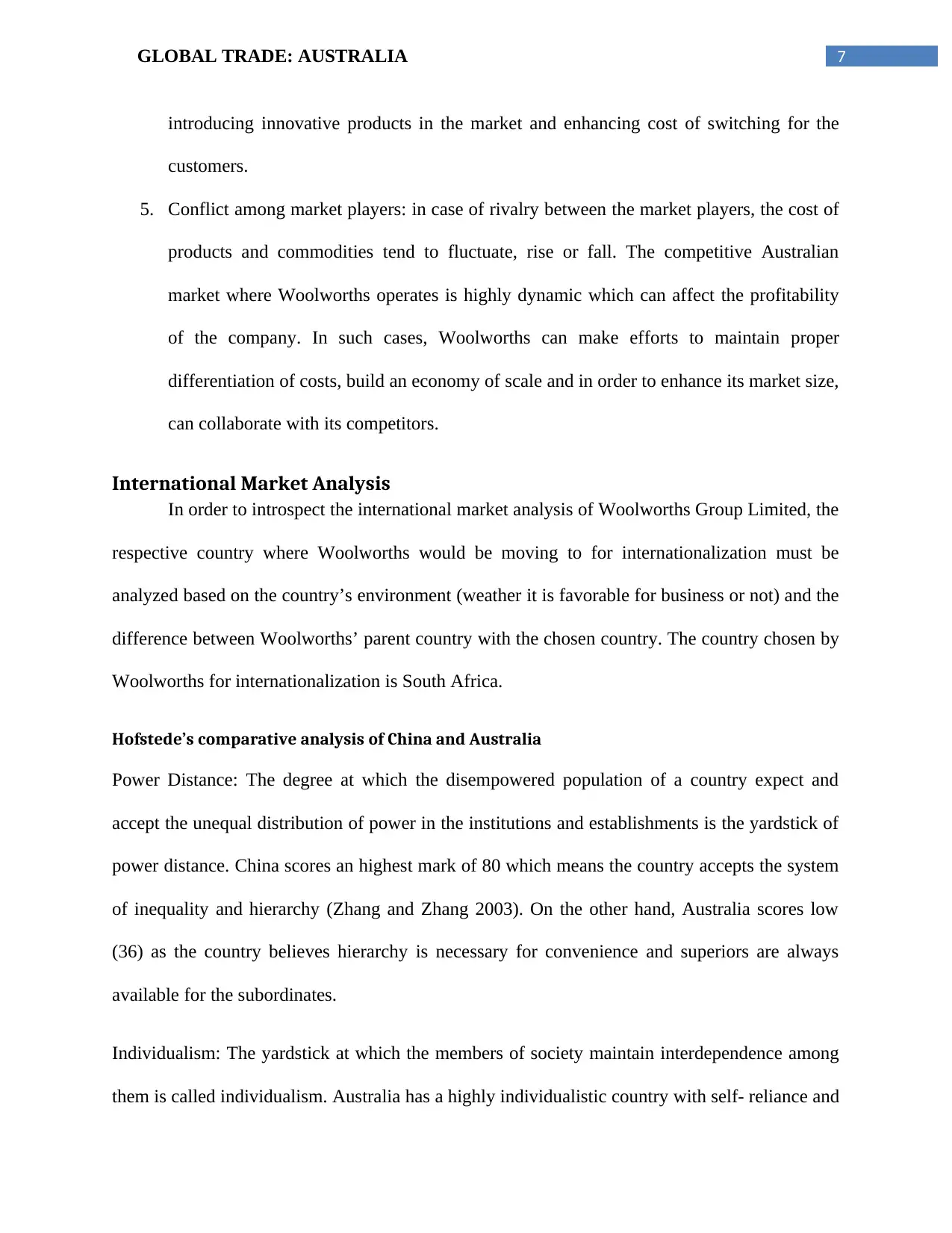
7GLOBAL TRADE: AUSTRALIA
introducing innovative products in the market and enhancing cost of switching for the
customers.
5. Conflict among market players: in case of rivalry between the market players, the cost of
products and commodities tend to fluctuate, rise or fall. The competitive Australian
market where Woolworths operates is highly dynamic which can affect the profitability
of the company. In such cases, Woolworths can make efforts to maintain proper
differentiation of costs, build an economy of scale and in order to enhance its market size,
can collaborate with its competitors.
International Market Analysis
In order to introspect the international market analysis of Woolworths Group Limited, the
respective country where Woolworths would be moving to for internationalization must be
analyzed based on the country’s environment (weather it is favorable for business or not) and the
difference between Woolworths’ parent country with the chosen country. The country chosen by
Woolworths for internationalization is South Africa.
Hofstede’s comparative analysis of China and Australia
Power Distance: The degree at which the disempowered population of a country expect and
accept the unequal distribution of power in the institutions and establishments is the yardstick of
power distance. China scores an highest mark of 80 which means the country accepts the system
of inequality and hierarchy (Zhang and Zhang 2003). On the other hand, Australia scores low
(36) as the country believes hierarchy is necessary for convenience and superiors are always
available for the subordinates.
Individualism: The yardstick at which the members of society maintain interdependence among
them is called individualism. Australia has a highly individualistic country with self- reliance and
introducing innovative products in the market and enhancing cost of switching for the
customers.
5. Conflict among market players: in case of rivalry between the market players, the cost of
products and commodities tend to fluctuate, rise or fall. The competitive Australian
market where Woolworths operates is highly dynamic which can affect the profitability
of the company. In such cases, Woolworths can make efforts to maintain proper
differentiation of costs, build an economy of scale and in order to enhance its market size,
can collaborate with its competitors.
International Market Analysis
In order to introspect the international market analysis of Woolworths Group Limited, the
respective country where Woolworths would be moving to for internationalization must be
analyzed based on the country’s environment (weather it is favorable for business or not) and the
difference between Woolworths’ parent country with the chosen country. The country chosen by
Woolworths for internationalization is South Africa.
Hofstede’s comparative analysis of China and Australia
Power Distance: The degree at which the disempowered population of a country expect and
accept the unequal distribution of power in the institutions and establishments is the yardstick of
power distance. China scores an highest mark of 80 which means the country accepts the system
of inequality and hierarchy (Zhang and Zhang 2003). On the other hand, Australia scores low
(36) as the country believes hierarchy is necessary for convenience and superiors are always
available for the subordinates.
Individualism: The yardstick at which the members of society maintain interdependence among
them is called individualism. Australia has a highly individualistic country with self- reliance and
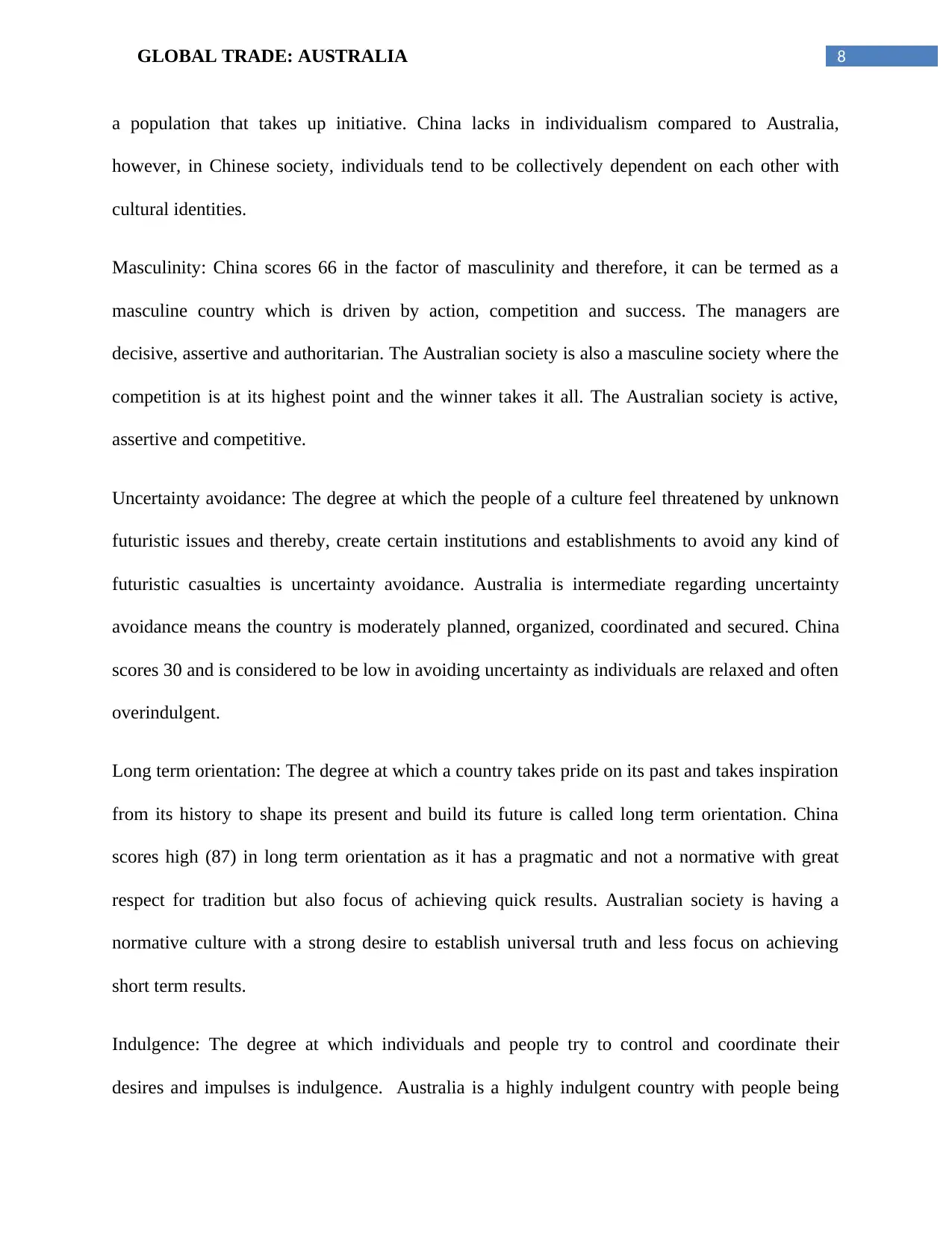
8GLOBAL TRADE: AUSTRALIA
a population that takes up initiative. China lacks in individualism compared to Australia,
however, in Chinese society, individuals tend to be collectively dependent on each other with
cultural identities.
Masculinity: China scores 66 in the factor of masculinity and therefore, it can be termed as a
masculine country which is driven by action, competition and success. The managers are
decisive, assertive and authoritarian. The Australian society is also a masculine society where the
competition is at its highest point and the winner takes it all. The Australian society is active,
assertive and competitive.
Uncertainty avoidance: The degree at which the people of a culture feel threatened by unknown
futuristic issues and thereby, create certain institutions and establishments to avoid any kind of
futuristic casualties is uncertainty avoidance. Australia is intermediate regarding uncertainty
avoidance means the country is moderately planned, organized, coordinated and secured. China
scores 30 and is considered to be low in avoiding uncertainty as individuals are relaxed and often
overindulgent.
Long term orientation: The degree at which a country takes pride on its past and takes inspiration
from its history to shape its present and build its future is called long term orientation. China
scores high (87) in long term orientation as it has a pragmatic and not a normative with great
respect for tradition but also focus of achieving quick results. Australian society is having a
normative culture with a strong desire to establish universal truth and less focus on achieving
short term results.
Indulgence: The degree at which individuals and people try to control and coordinate their
desires and impulses is indulgence. Australia is a highly indulgent country with people being
a population that takes up initiative. China lacks in individualism compared to Australia,
however, in Chinese society, individuals tend to be collectively dependent on each other with
cultural identities.
Masculinity: China scores 66 in the factor of masculinity and therefore, it can be termed as a
masculine country which is driven by action, competition and success. The managers are
decisive, assertive and authoritarian. The Australian society is also a masculine society where the
competition is at its highest point and the winner takes it all. The Australian society is active,
assertive and competitive.
Uncertainty avoidance: The degree at which the people of a culture feel threatened by unknown
futuristic issues and thereby, create certain institutions and establishments to avoid any kind of
futuristic casualties is uncertainty avoidance. Australia is intermediate regarding uncertainty
avoidance means the country is moderately planned, organized, coordinated and secured. China
scores 30 and is considered to be low in avoiding uncertainty as individuals are relaxed and often
overindulgent.
Long term orientation: The degree at which a country takes pride on its past and takes inspiration
from its history to shape its present and build its future is called long term orientation. China
scores high (87) in long term orientation as it has a pragmatic and not a normative with great
respect for tradition but also focus of achieving quick results. Australian society is having a
normative culture with a strong desire to establish universal truth and less focus on achieving
short term results.
Indulgence: The degree at which individuals and people try to control and coordinate their
desires and impulses is indulgence. Australia is a highly indulgent country with people being
⊘ This is a preview!⊘
Do you want full access?
Subscribe today to unlock all pages.

Trusted by 1+ million students worldwide
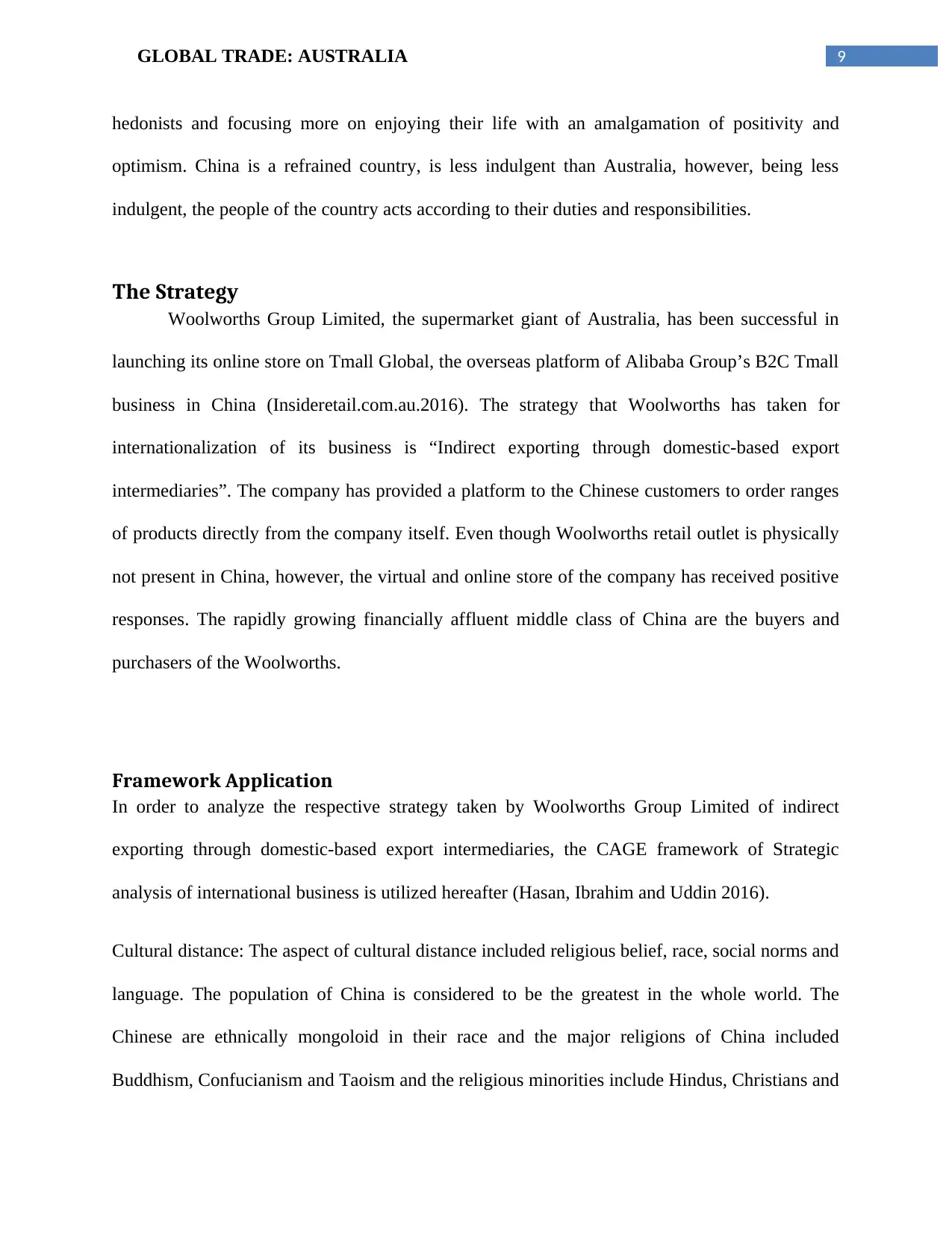
9GLOBAL TRADE: AUSTRALIA
hedonists and focusing more on enjoying their life with an amalgamation of positivity and
optimism. China is a refrained country, is less indulgent than Australia, however, being less
indulgent, the people of the country acts according to their duties and responsibilities.
The Strategy
Woolworths Group Limited, the supermarket giant of Australia, has been successful in
launching its online store on Tmall Global, the overseas platform of Alibaba Group’s B2C Tmall
business in China (Insideretail.com.au.2016). The strategy that Woolworths has taken for
internationalization of its business is “Indirect exporting through domestic-based export
intermediaries”. The company has provided a platform to the Chinese customers to order ranges
of products directly from the company itself. Even though Woolworths retail outlet is physically
not present in China, however, the virtual and online store of the company has received positive
responses. The rapidly growing financially affluent middle class of China are the buyers and
purchasers of the Woolworths.
Framework Application
In order to analyze the respective strategy taken by Woolworths Group Limited of indirect
exporting through domestic-based export intermediaries, the CAGE framework of Strategic
analysis of international business is utilized hereafter (Hasan, Ibrahim and Uddin 2016).
Cultural distance: The aspect of cultural distance included religious belief, race, social norms and
language. The population of China is considered to be the greatest in the whole world. The
Chinese are ethnically mongoloid in their race and the major religions of China included
Buddhism, Confucianism and Taoism and the religious minorities include Hindus, Christians and
hedonists and focusing more on enjoying their life with an amalgamation of positivity and
optimism. China is a refrained country, is less indulgent than Australia, however, being less
indulgent, the people of the country acts according to their duties and responsibilities.
The Strategy
Woolworths Group Limited, the supermarket giant of Australia, has been successful in
launching its online store on Tmall Global, the overseas platform of Alibaba Group’s B2C Tmall
business in China (Insideretail.com.au.2016). The strategy that Woolworths has taken for
internationalization of its business is “Indirect exporting through domestic-based export
intermediaries”. The company has provided a platform to the Chinese customers to order ranges
of products directly from the company itself. Even though Woolworths retail outlet is physically
not present in China, however, the virtual and online store of the company has received positive
responses. The rapidly growing financially affluent middle class of China are the buyers and
purchasers of the Woolworths.
Framework Application
In order to analyze the respective strategy taken by Woolworths Group Limited of indirect
exporting through domestic-based export intermediaries, the CAGE framework of Strategic
analysis of international business is utilized hereafter (Hasan, Ibrahim and Uddin 2016).
Cultural distance: The aspect of cultural distance included religious belief, race, social norms and
language. The population of China is considered to be the greatest in the whole world. The
Chinese are ethnically mongoloid in their race and the major religions of China included
Buddhism, Confucianism and Taoism and the religious minorities include Hindus, Christians and
Paraphrase This Document
Need a fresh take? Get an instant paraphrase of this document with our AI Paraphraser
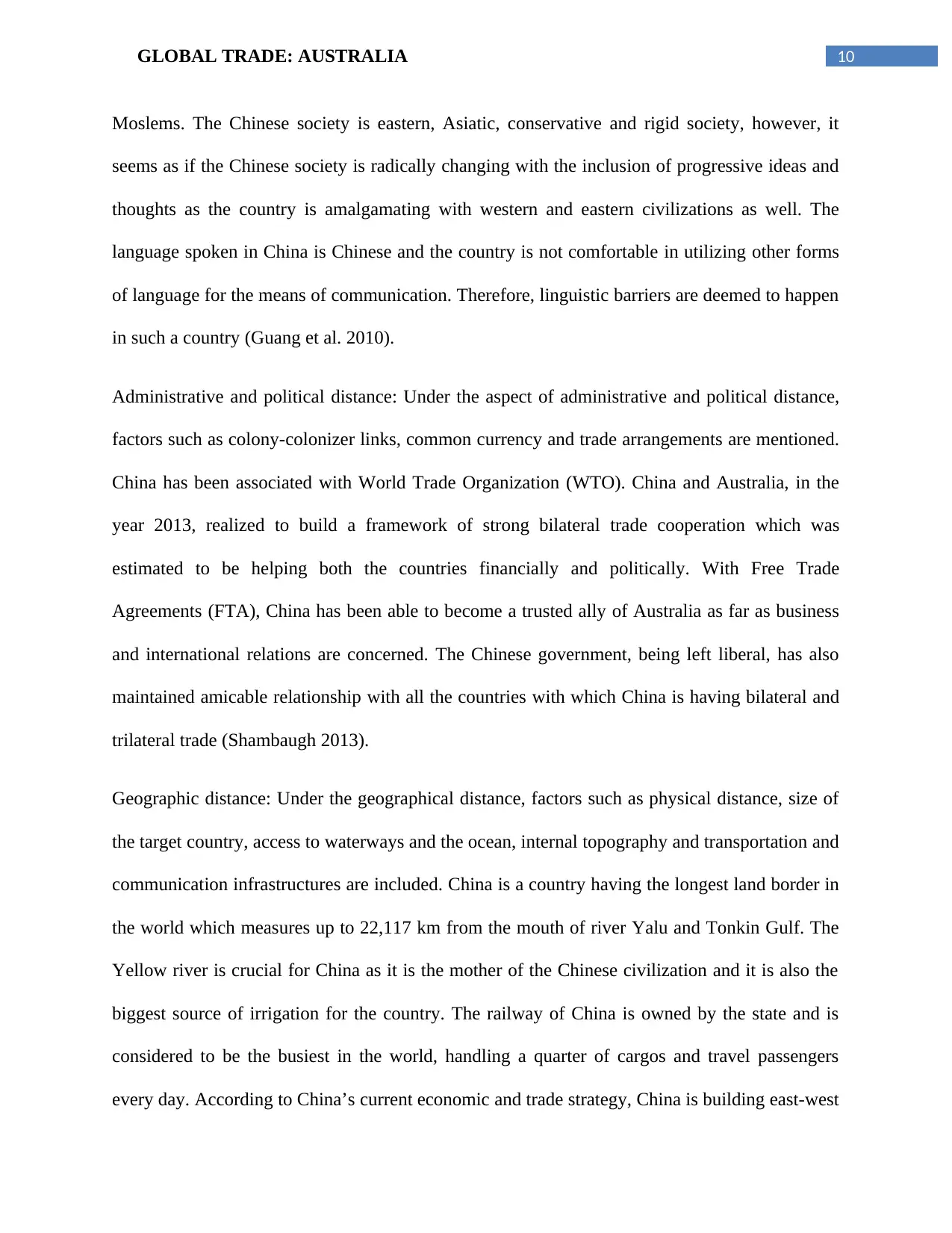
10GLOBAL TRADE: AUSTRALIA
Moslems. The Chinese society is eastern, Asiatic, conservative and rigid society, however, it
seems as if the Chinese society is radically changing with the inclusion of progressive ideas and
thoughts as the country is amalgamating with western and eastern civilizations as well. The
language spoken in China is Chinese and the country is not comfortable in utilizing other forms
of language for the means of communication. Therefore, linguistic barriers are deemed to happen
in such a country (Guang et al. 2010).
Administrative and political distance: Under the aspect of administrative and political distance,
factors such as colony-colonizer links, common currency and trade arrangements are mentioned.
China has been associated with World Trade Organization (WTO). China and Australia, in the
year 2013, realized to build a framework of strong bilateral trade cooperation which was
estimated to be helping both the countries financially and politically. With Free Trade
Agreements (FTA), China has been able to become a trusted ally of Australia as far as business
and international relations are concerned. The Chinese government, being left liberal, has also
maintained amicable relationship with all the countries with which China is having bilateral and
trilateral trade (Shambaugh 2013).
Geographic distance: Under the geographical distance, factors such as physical distance, size of
the target country, access to waterways and the ocean, internal topography and transportation and
communication infrastructures are included. China is a country having the longest land border in
the world which measures up to 22,117 km from the mouth of river Yalu and Tonkin Gulf. The
Yellow river is crucial for China as it is the mother of the Chinese civilization and it is also the
biggest source of irrigation for the country. The railway of China is owned by the state and is
considered to be the busiest in the world, handling a quarter of cargos and travel passengers
every day. According to China’s current economic and trade strategy, China is building east-west
Moslems. The Chinese society is eastern, Asiatic, conservative and rigid society, however, it
seems as if the Chinese society is radically changing with the inclusion of progressive ideas and
thoughts as the country is amalgamating with western and eastern civilizations as well. The
language spoken in China is Chinese and the country is not comfortable in utilizing other forms
of language for the means of communication. Therefore, linguistic barriers are deemed to happen
in such a country (Guang et al. 2010).
Administrative and political distance: Under the aspect of administrative and political distance,
factors such as colony-colonizer links, common currency and trade arrangements are mentioned.
China has been associated with World Trade Organization (WTO). China and Australia, in the
year 2013, realized to build a framework of strong bilateral trade cooperation which was
estimated to be helping both the countries financially and politically. With Free Trade
Agreements (FTA), China has been able to become a trusted ally of Australia as far as business
and international relations are concerned. The Chinese government, being left liberal, has also
maintained amicable relationship with all the countries with which China is having bilateral and
trilateral trade (Shambaugh 2013).
Geographic distance: Under the geographical distance, factors such as physical distance, size of
the target country, access to waterways and the ocean, internal topography and transportation and
communication infrastructures are included. China is a country having the longest land border in
the world which measures up to 22,117 km from the mouth of river Yalu and Tonkin Gulf. The
Yellow river is crucial for China as it is the mother of the Chinese civilization and it is also the
biggest source of irrigation for the country. The railway of China is owned by the state and is
considered to be the busiest in the world, handling a quarter of cargos and travel passengers
every day. According to China’s current economic and trade strategy, China is building east-west
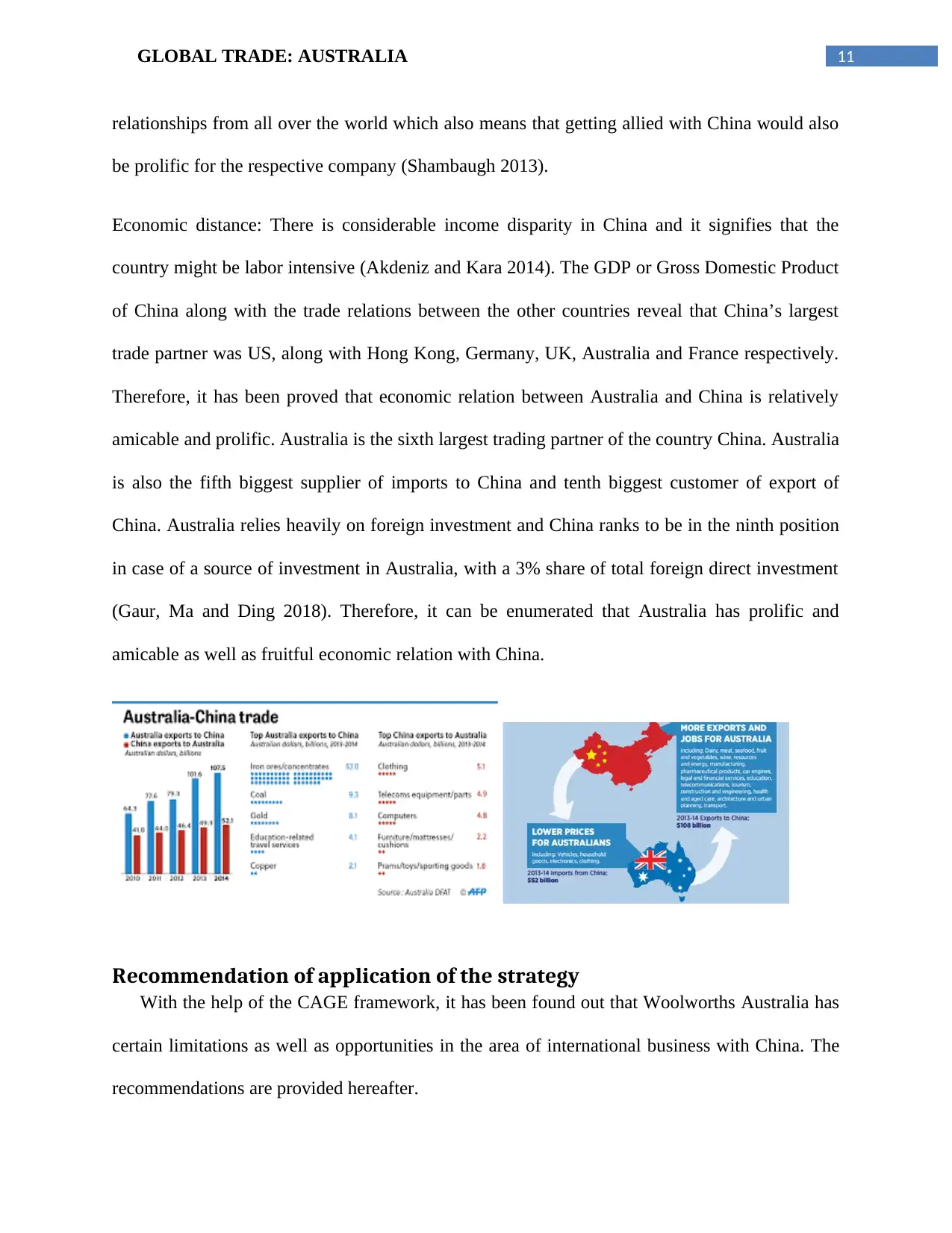
11GLOBAL TRADE: AUSTRALIA
relationships from all over the world which also means that getting allied with China would also
be prolific for the respective company (Shambaugh 2013).
Economic distance: There is considerable income disparity in China and it signifies that the
country might be labor intensive (Akdeniz and Kara 2014). The GDP or Gross Domestic Product
of China along with the trade relations between the other countries reveal that China’s largest
trade partner was US, along with Hong Kong, Germany, UK, Australia and France respectively.
Therefore, it has been proved that economic relation between Australia and China is relatively
amicable and prolific. Australia is the sixth largest trading partner of the country China. Australia
is also the fifth biggest supplier of imports to China and tenth biggest customer of export of
China. Australia relies heavily on foreign investment and China ranks to be in the ninth position
in case of a source of investment in Australia, with a 3% share of total foreign direct investment
(Gaur, Ma and Ding 2018). Therefore, it can be enumerated that Australia has prolific and
amicable as well as fruitful economic relation with China.
Recommendation of application of the strategy
With the help of the CAGE framework, it has been found out that Woolworths Australia has
certain limitations as well as opportunities in the area of international business with China. The
recommendations are provided hereafter.
relationships from all over the world which also means that getting allied with China would also
be prolific for the respective company (Shambaugh 2013).
Economic distance: There is considerable income disparity in China and it signifies that the
country might be labor intensive (Akdeniz and Kara 2014). The GDP or Gross Domestic Product
of China along with the trade relations between the other countries reveal that China’s largest
trade partner was US, along with Hong Kong, Germany, UK, Australia and France respectively.
Therefore, it has been proved that economic relation between Australia and China is relatively
amicable and prolific. Australia is the sixth largest trading partner of the country China. Australia
is also the fifth biggest supplier of imports to China and tenth biggest customer of export of
China. Australia relies heavily on foreign investment and China ranks to be in the ninth position
in case of a source of investment in Australia, with a 3% share of total foreign direct investment
(Gaur, Ma and Ding 2018). Therefore, it can be enumerated that Australia has prolific and
amicable as well as fruitful economic relation with China.
Recommendation of application of the strategy
With the help of the CAGE framework, it has been found out that Woolworths Australia has
certain limitations as well as opportunities in the area of international business with China. The
recommendations are provided hereafter.
⊘ This is a preview!⊘
Do you want full access?
Subscribe today to unlock all pages.

Trusted by 1+ million students worldwide
1 out of 16
Related Documents
Your All-in-One AI-Powered Toolkit for Academic Success.
+13062052269
info@desklib.com
Available 24*7 on WhatsApp / Email
![[object Object]](/_next/static/media/star-bottom.7253800d.svg)
Unlock your academic potential
Copyright © 2020–2025 A2Z Services. All Rights Reserved. Developed and managed by ZUCOL.




